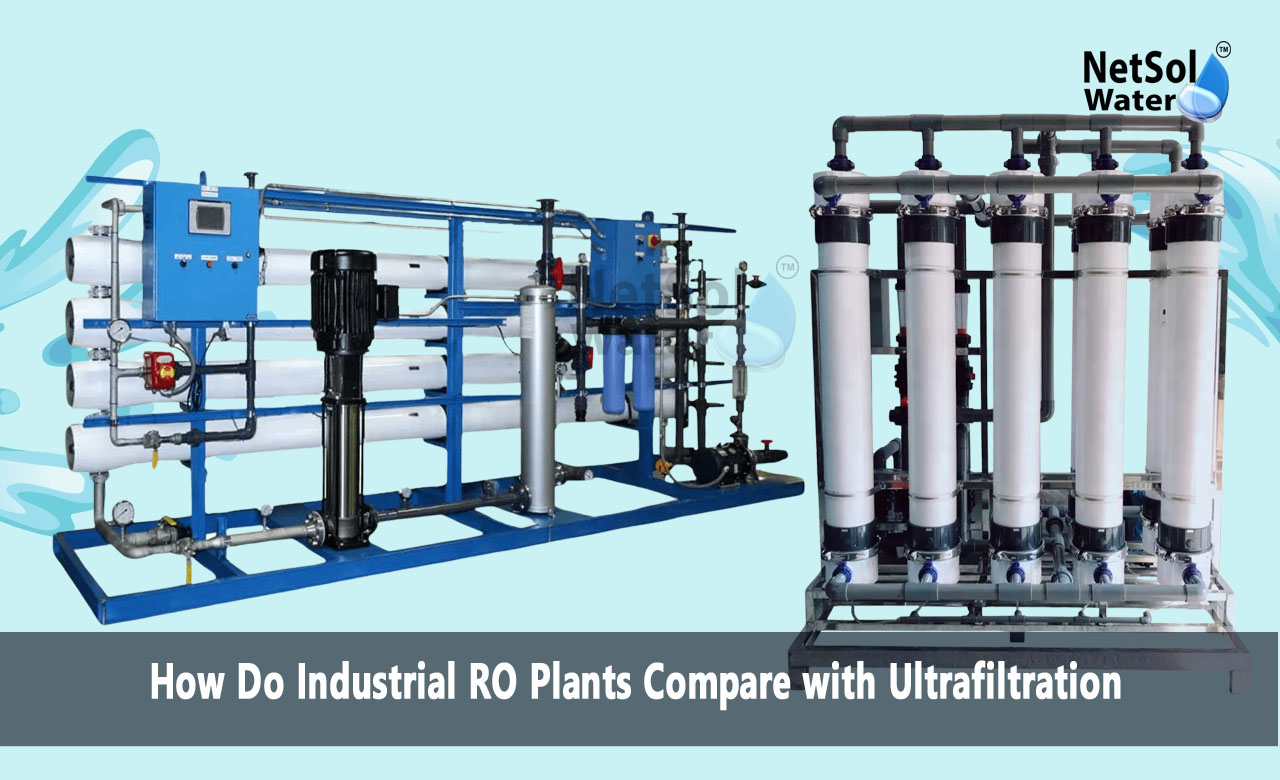How Do Industrial RO Plants Compare with Ultrafiltration?
Industrial water treatment shapes many processes in factories and plants. Netsol Water stands out as a leading manufacturer for these systems. We work with clients to design and deliver reliable solutions. We know how critical it is to choose the right method. The choice affects water quality, cost and efficiency. Industrial RO plants and ultrafiltration deliver clean water by removing unwanted particles. Yet they differ in how they work and in their results. In this blog we will compare these two technologies. We will explore how they function, what they remove how much energy they use and how they suit different tasks.
Filtration Mechanism
Industrial water treatment begins with a solid process. Understanding the filtration mechanism matters a great deal. It tells you what each system can do and what it cannot do. Let us have a look at some of the ways these systems work.
Reverse Osmosis Action
Industrial RO uses a semipermeable membrane. It applies high pressure to push water through that membrane. The membrane blocks dissolved solids and salts. It results in very pure water. You will see low levels of ions after this process.
Ultrafiltration Action
Ultrafiltration relies on a membrane too. It removes particles larger than certain sizes. It stops bacteria and some viruses. It lets most salts pass through. It operates under lower pressure. It uses less energy than RO.
Both methods use membranes that trap unwanted matter. RO works at the molecular level. Ultrafiltration works at the particle level. This difference makes each method suitable for specific jobs.
Water Quality Output
Water quality stands at the core of every project. It decides whether treated water meets use standards. Let us have a look at some measures of how each system performs.
Purity Levels
Reverse Osmosis removes nearly all dissolved solids. It cuts down total dissolved solids by up to 99 percent. You will see near pure water if you need it.
Clarity and Safety
Ultrafiltration clears out suspended solids and many pathogens. It does not remove all dissolved salts. It still gives safe water for many uses. It often serves as a pre treatment for RO.
Clean water quality follows clear rules. RO delivers the highest purity. Ultrafiltration delivers safe water with fewer dissolved solids removed.
Energy and Operating Costs
Cost and energy use affect your bottom line. Running filters can add to your power bill. They also affect maintenance spends. Let us have a look at some factors here.
Pressure Requirements
Reverse Osmosis needs pressure often above 150 psi. This pressure pumps water through tight membranes. It drives up energy use. Engineers often install energy recovery units. They help to lower costs.
Lower Pressure Needs
Ultrafiltration works at pressures near 30 to 80 psi. Pumps run at mild levels. This setting saves energy. It cuts down on wear and tear too.
High pressure means high cost over time. Low pressure cuts cost. The choice will hinge on your budget and purity goals.
Maintenance and Lifespan
Maintenance needs shape long term project success. A system that fails often will cost more. It may force downtime. Let us have a look at some key points.
Membrane Cleaning
Reverse Osmosis membranes need periodic cleaning. They face scaling foulants and biofilm growth. You must use chemicals and flush cycles. You will plan for occasional downtime.
Simple Backwash
Ultrafiltration membranes need backwash cycles. They handle suspended solids with ease. You schedule backwash at regular intervals. You avoid heavy chemical use.
Both systems need care. RO needs deeper clean work. Ultrafiltration needs simpler maintenance. The lifespan may range from five to ten years. Proper care boosts these numbers.
Application and Suitability
Matching a system to its task drives value. You must pick the right tool for the right job. Let us have a look at some common uses.
High Purity Needs
When you need very low mineral levels you pick RO. You see this in electronics production and power plant boilers. Industries that demand ultra pure water rely on RO.
Bulk Clarification
When you need to remove turbidity and microbes you choose ultrafiltration. You see this in beverage lines and cooling towers. It works well as a pre filter for RO plants.
Each method fits a set of targets. You must weigh purity goals energy limits and cost. You also must review feed water quality and project scale.
Conclusion
Industrial RO plants and Ultrafiltration differ in mechanism, energy need, output and upkeep. They share the goal of supplying clean water. Netsol Water stands as a leading manufacturer of both solutions. We guide you to the best choice. We design systems that meet your needs. We deliver reliable results on time. Reach out now for expert help. Request a consultation to learn more about how do industrial RO plants compare with ultrafiltration. Let us help you select the perfect system for your project.
Contact Netsol Water at:
Phone: +919650608473, Email: enquiry@netsolwater.com



